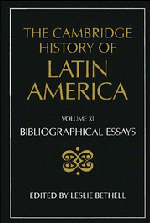Book contents
- Frontmatter
- I THE INDIGENOUS PEOPLES OF MIDDLE AND SOUTH AMERICA ON THE EVE OF THE CONQUEST
- II COLONIAL SPANISH AMERICA
- III COLONIAL BRAZIL
- IV THE INDEPENDENCE OF LATIN AMERICA
- V LATIN AMERICA: ECONOMY, SOCIETY, POLITICS, c. 1820 TO c. 1870
- VI LATIN AMERICA: ECONOMY, SOCIETY, POLITICS, c. 1870 to 1930
- 1 Latin America and the international economy, 1870–1914
- 2 Latin America and the international economy, 1914–1929
- 3 Population
- 4 Rural Spanish America
- 5 The growth of cities
- 6 Industry
- 7 The urban working class and early labour movements
- 8 The Catholic church
- 9 Mexico: Restored republic and Porfiriato, 1867–1910
- 10 The Mexican Revolution, 1910–1920
- 11 Mexico: Revolution and reconstruction in the 1920s
- 12 Central America
- 13 Cuba
- 14 Puerto Rico
- 15 The Dominican Republic
- 16 Haiti
- 17 Argentina: Economy, 1870–1914
- 18 Argentina: Society and politics, 1880–1916
- 19 Argentina, 1914–1930
- 20 Uruguay
- 21 Paraguay
- 22 Chile
- 23 Bolivia
- 24 Peru
- 25 Colombia
- 26 Ecuador
- 27 Venezuela
- 28 Brazil: Economy
- 29 Brazil: Society and politics, 1870–1889
- 30 Brazil: Society and politics, 1889–1930
- VII LATIN AMERICA: ECONOMY, SOCIETY, POLITICS, 1930 to c. 1990
- VIII IDEAS IN LATIN AMERICA SINCE INDEPENDENCE
- IX LATIN AMERICAN CULTURE SINCE INDEPENDENCE
- X THE INTERNATIONAL RELATIONS OF LATIN AMERICA SINCE INDEPENDENCE
- THE CAMBRIDGE HISTORY OF LATIN AMERICA
2 - Latin America and the international economy, 1914–1929
from VI - LATIN AMERICA: ECONOMY, SOCIETY, POLITICS, c. 1870 to 1930
Published online by Cambridge University Press: 28 March 2008
- Frontmatter
- I THE INDIGENOUS PEOPLES OF MIDDLE AND SOUTH AMERICA ON THE EVE OF THE CONQUEST
- II COLONIAL SPANISH AMERICA
- III COLONIAL BRAZIL
- IV THE INDEPENDENCE OF LATIN AMERICA
- V LATIN AMERICA: ECONOMY, SOCIETY, POLITICS, c. 1820 TO c. 1870
- VI LATIN AMERICA: ECONOMY, SOCIETY, POLITICS, c. 1870 to 1930
- 1 Latin America and the international economy, 1870–1914
- 2 Latin America and the international economy, 1914–1929
- 3 Population
- 4 Rural Spanish America
- 5 The growth of cities
- 6 Industry
- 7 The urban working class and early labour movements
- 8 The Catholic church
- 9 Mexico: Restored republic and Porfiriato, 1867–1910
- 10 The Mexican Revolution, 1910–1920
- 11 Mexico: Revolution and reconstruction in the 1920s
- 12 Central America
- 13 Cuba
- 14 Puerto Rico
- 15 The Dominican Republic
- 16 Haiti
- 17 Argentina: Economy, 1870–1914
- 18 Argentina: Society and politics, 1880–1916
- 19 Argentina, 1914–1930
- 20 Uruguay
- 21 Paraguay
- 22 Chile
- 23 Bolivia
- 24 Peru
- 25 Colombia
- 26 Ecuador
- 27 Venezuela
- 28 Brazil: Economy
- 29 Brazil: Society and politics, 1870–1889
- 30 Brazil: Society and politics, 1889–1930
- VII LATIN AMERICA: ECONOMY, SOCIETY, POLITICS, 1930 to c. 1990
- VIII IDEAS IN LATIN AMERICA SINCE INDEPENDENCE
- IX LATIN AMERICAN CULTURE SINCE INDEPENDENCE
- X THE INTERNATIONAL RELATIONS OF LATIN AMERICA SINCE INDEPENDENCE
- THE CAMBRIDGE HISTORY OF LATIN AMERICA
Summary
This essay concentrates on material concerning Latin America as a whole, and on certain works of particular use from a comparative point of view. The period is one of increasing integration with the world economy, particularly in the 1920s. It is therefore no surprise to find that most of the richest contemporary material is foreign in origin, and produced in English. It is also, typically, only the foreigner who perceived ‘Latin America’ as a whole. Both factors are reflected in this review of the secondary literature; the material of foreign origin is exceptionally valuable as long as its context is borne in mind.
The outstanding modern book on U.S. expansion in this period is Barbara Stallings, Banker to the Third World: U.S. Portfolio Investment in Latin America, 1900–1986 (Berkeley and Los Angeles 1987). The ‘classic’ and still invaluable sources are Cleona Lewis, America’s Stake in International Investments (Washington, D.C., 1938), M. Winkler, Investments of U.S. Capital in Latin America (Boston, 1929), J. F. Normano, The Struggle for South America (Boston, 1931), H. Feis, The Diplomacy of the Dollar (Baltimore, 1950) and M. Wilkins, The Maturing of Multinational Enterprise: American Business Abroad from 1914 to 1970 (Cambridge, Mass., 1974). An excellent comparative study is ECLA, Foreign Capital in Latin America (New York, 1955). On the expansion of banking, C. W. Phelps, The Foreign Expansion of American Banks (New York, 1927) and David Joslin, A Century of Banking in Latin America (London, 1963) are the key secondary sources. A brilliant more recent study is Carlos Marichal, A Century of Debt Crisis in Latin America: From Independence to the Great Depression 1820–1930 (Princeton, N.J., 1989).
- Type
- Chapter
- Information
- The Cambridge History of Latin America , pp. 326 - 331Publisher: Cambridge University PressPrint publication year: 1995
- 1
- Cited by

